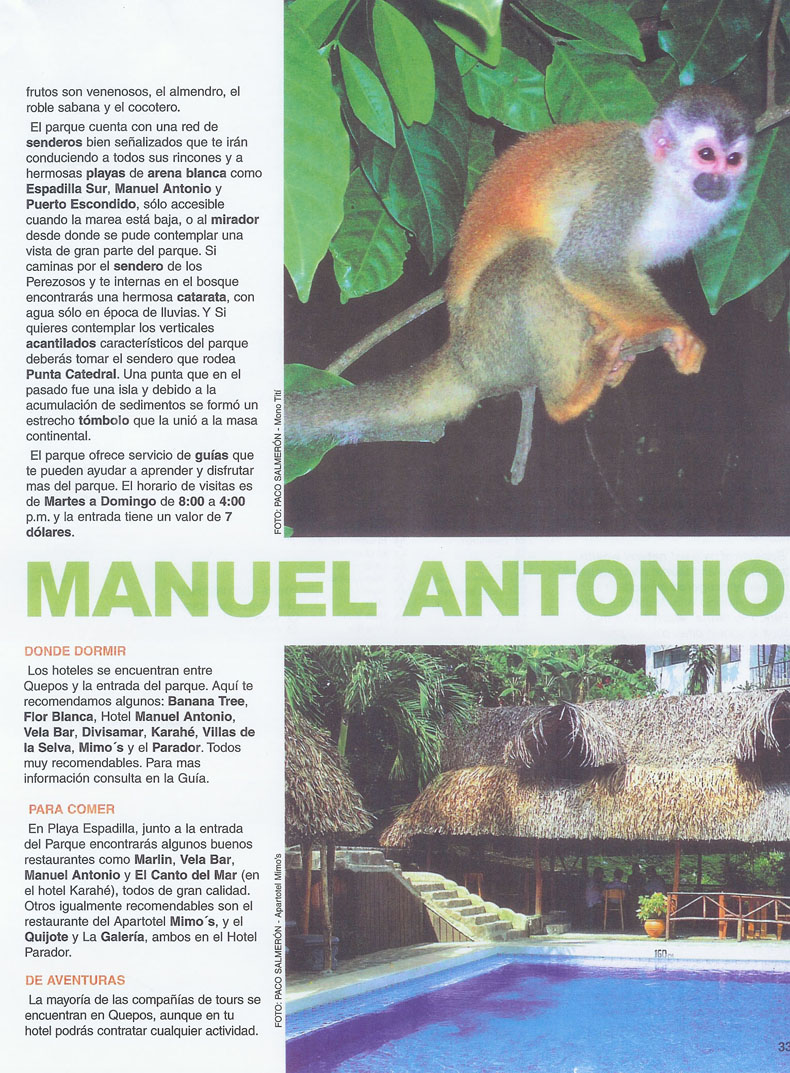LESSON PLAN
Teacher: Kimberly Prate
School: Elwood, John H. Glenn H.S.
Email: PRATE0010@YAHOO.COM
LESSON TITLE: Vida Salvaje (Wild life)
LESSON SKILL TARGETED: Comprehension (Shrum & Glisan model)
CLASS LEVEL: SPA III |
1.1 Interpersonal Communication 1.2 Interpretive Communication 1.3 Presentational Communication 2.1 Practices of Culture 2.2 Products of Culture 4.2 Cultural Comparisons |
I. OBJECTIVES
1. Students will read information about Manuel Antonio National Park. (1.2)
2. Students will present information about Manuel Antonio in the form of a role play. (1.1, 1.3)
3. Students will understand the significance of the initiation of national parks in Costa Rica that occurred in 1970 and how it preserved the wildlife. (2.1)
4. Students will correctly be able to identify some of the animals that make up the 109 species that live in the Manuel Antonio National Park. (2.2)
5. Students will compare and contrast the protection of wild life in the United States to wild life in Costa Rica. (4.2)
6. Students will compare and contrast national parks in Costa Rica. (4.2)
II. MATERIALS
1. Over head Projector
2. Transparency
3. PowerPoint presentation of wild life pictures
4. Computer with projector screen
5. Reading on Manuel Antonio (class set - see below)
6. VENN Diagram
7. Internet
III. PROCEDURES
Model II Phases + Sample Class Activities
Preparation
The teacher begins the lesson with the following questions:
a.) What is wild life (Vida Salvaje?)
The teacher uses an overhead projector and transparency to write down students’ answers. (See appendix A for illustration of the diagram used for this exercise.)
b.)How do we, in the United States, preserve wild life?
c.) What do we need to do, or what could we do to improve these practices and better protect the wild life?
The students watch a Power Point presentation which includes a slide show of wild life in Costa Rica.
d.) Do we have national parks in the United States? If so, name some and what are they functions?
Comprehension
The teacher gives the students the text (an article found in the magazine Guía del Pacífico Central) and instructs the students to skim the article, looking only at the pictures, the titles (including subtitles) as well as the bold printed words. Once the students recognize the subject to the article, Manuel Antonio National Park, the students will receive a hand-out with three columns on it. The columns are labeled, Descriptions of Manuel Antonio, Occupants (inhabitants that make up the park) and Services of Manuel Antonio. Students will separate these words into the most appropriate column. (See appendix B for illustration of the chart used for this exercise.)
Interpretation
In pairs, the students will answer the following questions in the target language regarding the reading:
Based on the fauna described in the article, what animals are you most excited abut seeing?
Application
The article mentions several times that guides are available to help enjoy and learn about the park. In pairs, the teacher instructs the students to role play. One student plays the role of a travel agent and the other student plays the tourist. With the knowledge they gained from the slide show presentation in addition to the article, the travel agent must convince the tourist to take their tour of Manuel Antonio instead of someone else’s. The teacher stresses that the motive of the travel agent is to “sell” their tour; therefore they must be convincing when answering the tourist questions and make the park sound like what it is, a paradise.
Extension
For homework, students are instructed to use the internet to do a search of another national park in Costa Rica. They must create a VENN diagram and include the information they find about the new park in the left circle of the diagram and in the right circle of the diagram they must include the information they already obtained from the article on Manuel Antonio. Any characteristics that the two parks share should be placed in the center of the diagram. Finally, they must choose one of these parks to visit and provide corresponding reasons. (See appendix C for example of diagram)
IV. CULTURAL INFORMATION
Product: Vida Salvaje
Practice: Preservation of Manuel Antonio
Perspective: To prevent the extinction of fauna and flora.
V. TECHNOLOGY USED
1. Computer (PowerPoint)
2. Overhead Projector3
3. Internet
